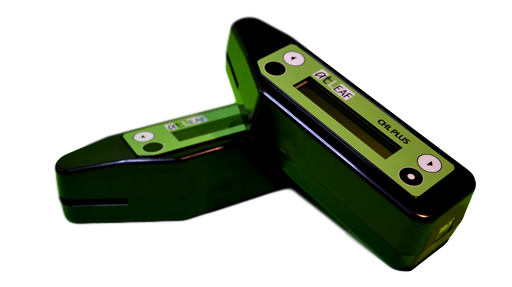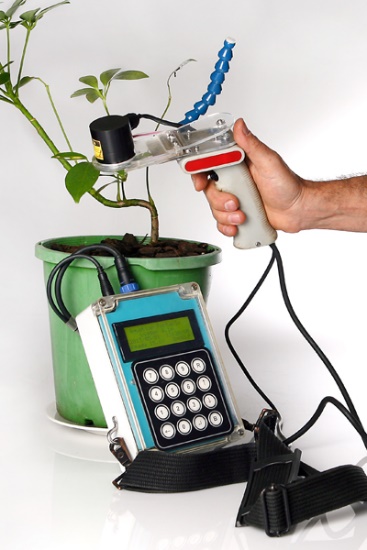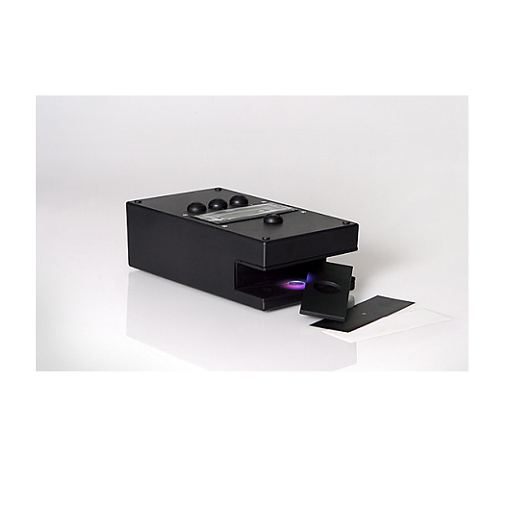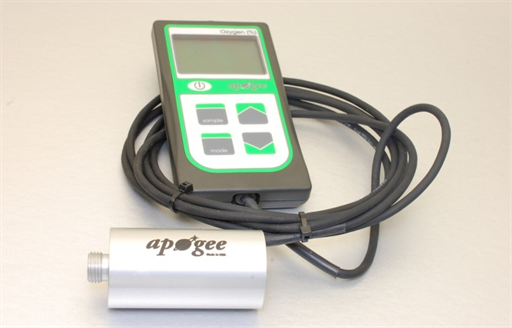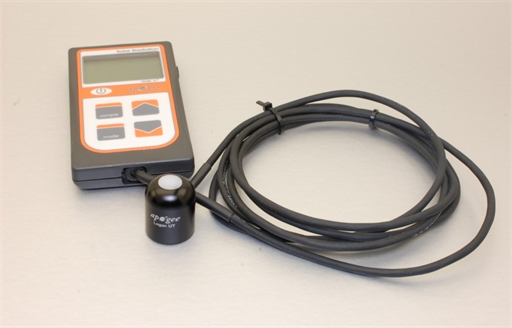Six Types of Plant Meters You Should Know

Plants require a delicate balance between living and nonliving factors to accomplish and maintain standard physiological functions. The depletion of essential nutrients or suboptimal environmental conditions can have devastating impacts on the growth and function of plants.
Instrument Choice offers a range of plant meters capable of measuring a variety of plant health indicators to help you to gain valuable insights into plant growth, how to optimise fertiliser, water usage, and how to increase yield potential.
Types of Plant Meters
Chlorophyll Meters
What is a Chlorophyll Meter?
A Chlorophyll plant meter measures the green pigment, called Chlorophyll, found in the leaves of plants. The quantity of Chlorophyll per unit area is a crucial indicator of a plant's photosynthetic capacity. Both environmental stressors and nutrient availability have an impact on chlorophyll levels, which highlights why testing the Chlorophyll within leaves is an essential task.
Chlorophyll Meter Product Example:
atLEAF CHL PLUS chlorophyll meter
Product Code: IC-CHLPLS
The atLEAF CHL PLUS is a powerful, handheld meter used to measure the relative chlorophyll content of green leaf plants noninvasively. Leaves up to 3mm thick can be sampled with a simple press of a button. The device can store up to 9554 readings, and the meter connects to a computer via USB so you can easily graph, trend, and share your data.
Fluorometers
What is a Fluorometer?
Any light energy that is absorbed by Chlorophyll molecules will have one of the following three outcomes;
- 1.Photosynthesis
- 2.Excess light energy dissipates as heat; or
- 3.Absorption and then re‐emittance as light (i.e., Chlorophyll Fluorescence).
These three processes occur in competition, so where there is an increase in the one, the other two will decrease and vice-versa. Environmental stressors will reduce the ability of a plant to metabolise normally. Abnormal metabolism creates an imbalance between the absorption of light energy by Chlorophyll and the use of energy in photosynthesis. Therefore, using a Fluorometer to measure the amount of Chlorophyll Fluorescence is a straightforward way to obtain a range of information about a plant's stress state.
Fluorometer Product Example:
Handheld Fluorometer & Portable Datalogger
Product Code: IC-3007
With its sensor mounted on a pistol grip, this Handheld Fluorometer Plant Meter makes field measurements quick and easy. To use, simply open the leaf clip, insert the leaf then a yield measurement can be taken by depressing the trigger.
Leaf Absorptance Meters
What is a Leaf Absorptance Meter?
Leaf Absorptance Meters measure the reflectance and absorptance of white light on plant leaves. Leaf absorptance and reflectance influence the proportion of light entering the photosystem of a plant. This measurement is a crucial tool in photosynthesis studies as it gives insight into the modulation of energy balance, energy dissipation, and plant stress analysis.
Leaf Absorptance Meter Product Example:
White-RAT Leaf Absorptance Meter
Product Code: IC-3012
The White-RAT Absorptance Meter provides a precise measurement of sample absorptance, transmittance, and reflectance. The meter directs red, green, and blue light onto the sample and then measures the proportion of transmitted and reflected light.
Oxygen Meters
What is an Oxygen Meter?
An Oxygen Meter is a type of plant meter designed to measure the amount of oxygen present in plant soil samples. Measuring soil using an oxygen meter is crucial as soil oxygen levels affect such plant physiological processes as nutrient uptake and respiration.
Oxygen Meter Product Example:
Oxygen Sensor with Handheld Meter
Product Code: IC-MO-200
The IC-MO-200 handheld meter accurately measures, displays, and stores oxygen levels from 5-100%. The device's broad measurement range allows it to excel in both lab and field environments.
Pyranometers
What is a Pyranometer?
A pyranometer detects and measures a portion of the solar spectrum generally between 350nm to 1100nm. The pyranometer uses a photodiode to convert the spectrum frequencies into a current. Total shortwave radiation is an essential component in determining evapotranspiration rates, energy balance, and net radiation upon the plants.
Pyranometer Product Example:
Pyranometer Separate Sensor With Handheld Meter
Product Code: IC-MP-200
The IC-MP-200 accurately measures the solar spectrum range from 350nm to 1200nm and has a capable result range of 0 to 1999 Wm-2. This handheld meter correctly displays and stores measurements while the separate sensor is entirely weatherproof, making this pyranometer ideal for field studies.
Quantum Sensor Meters
What is a Quantum Sensor Meter?
Quantum Sensor Meters quantify light intensity. They use an optical filter to create a uniform sensitivity to PAR (Photosynthetic Active Radiation) light. This data can be displayed instantaneously or logged over time. PAR light is the wavelengths of light within the visible range of 400 to 700nm, which drive photosynthesis. Most commonly, Quantum Sensor Meters are employed to take PPFD (Photosynthetic Photon Flux Density) measurements. These are the total number of PAR photons hitting a particular area. Quantum Sensor Meters and the resulting PPFD measurement give plant growers the average light level in their growing space. PPFD is essential information as it will have a direct correlation to a plant's growth and function.
Quantum Sensor Meter Product Example:
Full Spectrum Quantum Meter
Product Code: IC-MQ-500
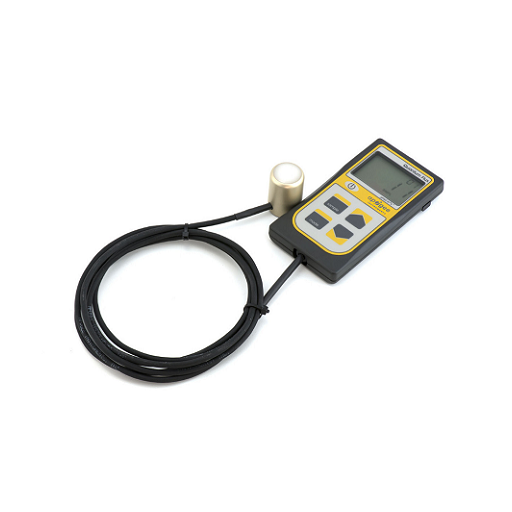 Encased in a rugged body and featuring a separate handheld sensor, the IC-MQ-500 is appropriate for PPFD measurement over plant canopies, greenhouses, and growth chambers, and reflected or under-canopy (transmitted) PPFD measurements in the same environments.
Encased in a rugged body and featuring a separate handheld sensor, the IC-MQ-500 is appropriate for PPFD measurement over plant canopies, greenhouses, and growth chambers, and reflected or under-canopy (transmitted) PPFD measurements in the same environments.
Conclusion
Growing and maintaining plants involves maintaining a balance between living and non-living factors that can impact a plant. Instrument Choice offers an extensive range of plant meters that are capable of measuring almost any plant health determining factor.
Want more information on any of the plant meters listed above? Contact an Instrument Choice Scientist; we're here to help! Call 1300 737 871 or email [email protected]
Also interesting
Levels of outdoor pollution from transport, fossil fuel burning and industry are on the increase, but few of us realise that the air inside our homes and workplaces isn't always as healthy as we would like it to be. To help you, your family, and work colleagues breathe easier, we have formulated six steps anyone can implement right away.

Do you already have a home weather station? Are you considering buying a weather station, but you’re unsure of how much maintenance is required? Would you like some maintenance tips that Instrument Choice scientists insist are essential to prolonging the life of your device, that will ensure accurate results?
Look no further!


